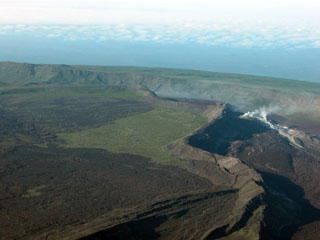Report on Sierra Negra (Ecuador) — January 1980
Scientific Event Alert Network Bulletin, vol. 5, no. 1 (January 1980)
Managing Editor: David Squires.
Sierra Negra (Ecuador) Last month's eruption obituary was premature
Please cite this report as:
Global Volcanism Program, 1980. Report on Sierra Negra (Ecuador) (Squires, D., ed.). Scientific Event Alert Network Bulletin, 5:1. Smithsonian Institution. https://doi.org/10.5479/si.GVP.SEAN198001-353050
Sierra Negra
Ecuador
0.83°S, 91.17°W; summit elev. 1124 m
All times are local (unless otherwise noted)
On 14 January the new lava delta, formed at Bahia Elizabeth by the 13 November eruption, was visited for the first time in 2 months. Hendrik Hoeck, inspecting the flow at night with binoculars, saw red spots along the flow length and some active feeding at vents 12 km inland. Motion was not visible along the 1-1.5-km flow front in daylight, but water temperatures of 50-60°C at distances of 30 m from the shore provide further evidence that the flow remains active. Pelicans and Franklin's gulls were concentrated in the area, presumably feeding on killed marine organisms, and two dead green turtles were observed. A pack of feral dogs appears to have been cut off by the new flows from more vegetated parts of Sierra Negra, and it is feared that they may cross the barren older lava flows to reach volcán Alcedo to the N. Alcedo has not been threatened with feral dogs and it is the home of the largest population of giant tortoises in the Galápagos.
Arnaldo Tupiza walked about 6 km inland on 14 January, noting flow thickness of 3-5 m, two 10 m-diameter "pools" of molten lava, and another major flow diverging toward the NE. The most active vents were farther W, along the circumferential fissure, than any previously reported, and it is not yet clear whether activity has resumed after migrating westward or whether the westerly vents were not recognized during previous observations from the vigorously steaming E end of the fissure system. The mid-January observations indicate an active fissure length of 8 km.
Geological Summary. The broad shield volcano of Sierra Negra at the southern end of Isabela Island contains a shallow 7 x 10.5 km caldera that is the largest in the Galápagos Islands. Flank vents abound, including cinder cones and spatter cones concentrated along an ENE-trending rift system and tuff cones along the coast and forming offshore islands. Although it is the largest of the five major Isabela volcanoes, it has the flattest slopes, averaging less than 5° and diminishing to 2° near the coast. A sinuous 14-km-long, N-S-trending ridge occupies the west part of the caldera floor, which lies only about 100 m below its rim. The Volcán de Azufre fumarolic area lies within a graben between this ridge and the west caldera wall. Lava flows from a major eruption in 1979 extend all the way to the north coast from circumferential fissure vents on the upper northern flank.
Information Contacts: H. Hoeck and A. Tupiza, CDRS, Galápagos.

